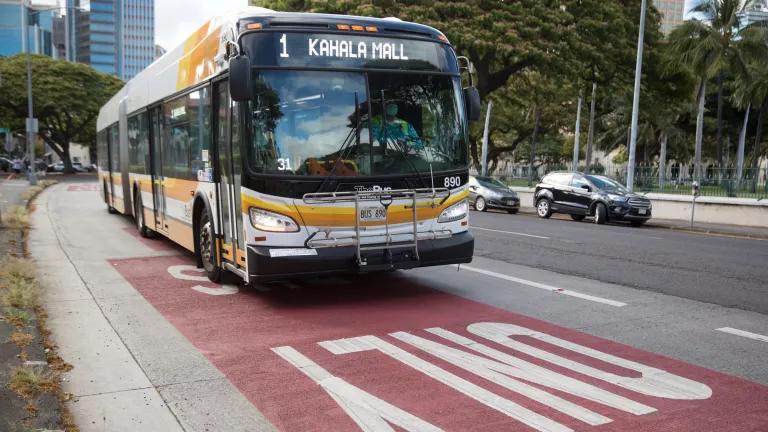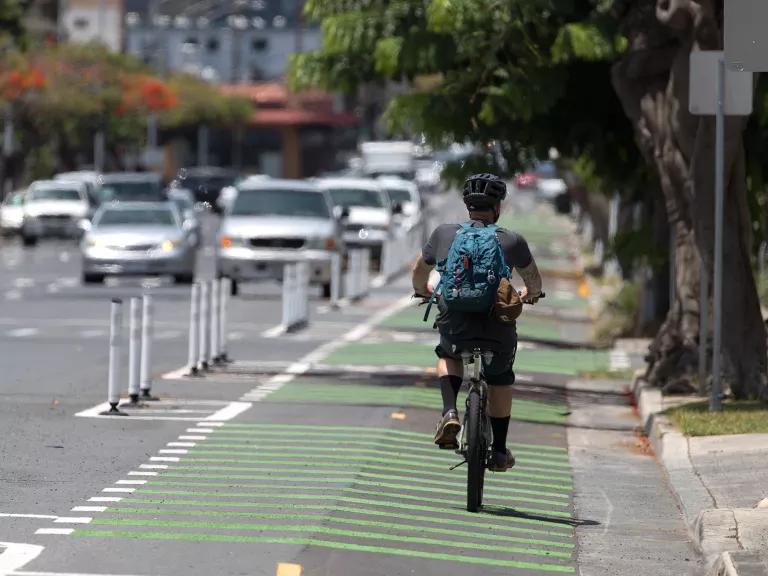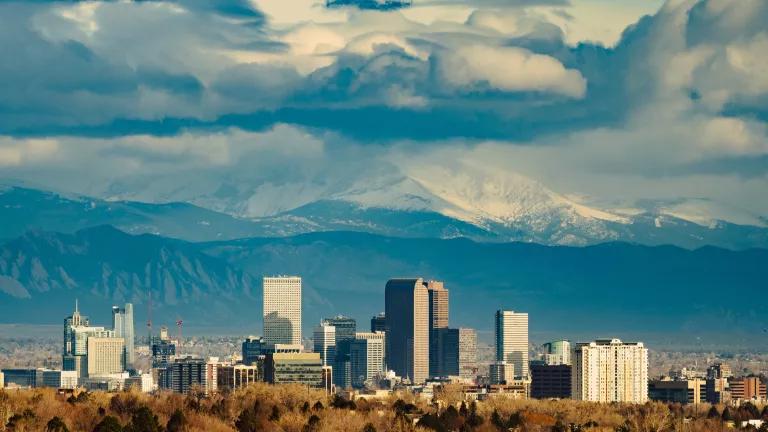Honolulu’s New Bus-Only Lane Puts People and Climate First
Honolulu has rolled out the red carpet for public transit with its brand new bus-only lane, the city’s first in 30 years. Now, the most sustainable and safe form of transportation will move people faster and more reliably, too.

A bus using the new designated bus lane on King St. in Honolulu
Marco Garcia for NRDC
Honolulu has rolled out the red carpet for public transit with its brand new bus-only lane, the city’s first in 30 years. Now, the most sustainable and safe form of transportation will move people faster and more reliably, too.
In partnership with the Bloomberg Philanthropies American Cities Climate Challenge, Honolulu’s Department of Transportation Services is giving buses the preferred treatment on King Street with a designated bus-only lane, painting the right lane a bright red to create the first major transit-only lane since the 1980s. This will improve bus speed and safety on one of the busiest corridors through downtown and benefit thousands of island residents who ride the 36 bus routes that converge on this part of downtown.
Improving climate-friendly transportation

A cyclist riding in the Pensacola St. bike lane
Marco Garcia for NRDC
Along with a new bike lane that opened this fall along Pensacola Avenue and another under construction on Ward Avenue, TheBusLane advances implementation of the city’s Complete Streets policy and Mayor Kirk Caldwell’s climate action goals.
“The new bus lane is a big step forward in creating a more sustainable and equitable transportation network for local residents, and helping us accelerate the transition to a 100 percent clean transportation future for our island,” says Mayor Caldwell in recent press coverage.
King Street is ideal for this bus lane, which will run from Dillingham Boulevard to Alapai Street. The route traverses the diverse Chinatown and downtown neighborhoods, including residential and commercial centers. A whopping 36 bus lines, coming from all parts of the island, feed into this bustling main artery. Currently, at rush hour, half of all people on the street are on the bus, which until now has been stuck in traffic.
King Street’s right-most lane has already functioned as a de facto bus lane, but buses have to contend with merging cars and compete for road space, all of which impedes bus flow and causes delays and bus rider injuries. A dedicated, full-time track is a welcome and crucial addition that will not only serve the current volume of riders but, with an improved commuter experience, also promote increased ridership.
Meeting the needs of the many
A significant proportion of residents already rely on buses and alternate modes of transportation since about 22 percent of renter households in central Honolulu do not own a car, and almost 60 percent of renter households island-wide have only one car or none. In addition, the elderly population, which depends heavily on buses, is expected to grow to 24 percent of the state’s overall population by 2045, increasing the need even further.
The city’s Complete Streets projects help meet these needs by expanding sustainable mobility options—walking, biking, and buses—that will also help the mayor’s goal of 100 percent clean ground transportation by 2045.
“Every change we make to address the climate crisis can build a stronger local economy, reduce long-term costs for residents, build safer streets for all residents, and ensure that our communities are resilient,” says Mayor Caldwell.
“Historically, transit riders and pedestrians have been marginalized when it comes to transportation,” says Renee Espiau, the city’s Complete Streets administrator in a recent press release. “Now we’re trying to change that mindset, to give priority to them instead of to car drivers.”
In concert with community members and stakeholders, the city plans to design solutions that address the needs of each community with a mix of increased public transit, protected bike paths, and safer, more walkable pedestrian pathways.
“We have about 800 miles of roadways island-wide and virtually no sidewalks,” notes Espiau in a recent press release. The new King Street bus lane will serve as the backbone for a network of other bus lanes, which will then connect with future light-rail stations.
Moving faster to move Honolulu forward

The King St. designated bus lane.
City & County of Honolulu
Thanks to Nelson\Nygaard support through the Climate Challenge, Honolulu was able to cut a year out of the process. Departments citywide have stepped up in collaboration, including planning and permitting, resilience and sustainability staff, traffic engineers, and construction teams working on other projects, as well as as community partners such as the Blue Planet Foundation.
After more than 30 years, King Street’s new bus lane is poised to jump-start Honolulu on its path to a greener future.



